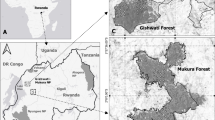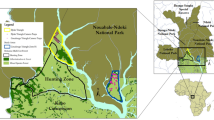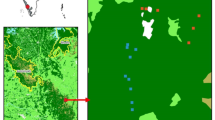Abstract
Context
Forest-agricultural mosaics are now considered critical for biodiversity. Within these landscapes, the type of land use surrounding remnant forests influences the ability of arboreal non-flying wildlife to travel, disperse and ultimately survive, making arboreal species disproportionally impacted from habitat change. To inform land management strategies we must first understand how wildlife, including arboreal taxa, respond to heterogeneous landscapes.
Objectives
Here, we examine the occurrence patterns of four arboreal and three semi-terrestrial primate species in response to agroforest landscape characteristics in southern Guinea-Bissau, West Africa.
Methods
We combine results from arboreal and terrestrial camera traps across Cantanhez National Park (1067 km2). We fit occupancy models using anthropogenic and environmental covariates generated via remote sensing and in-situ vegetation surveys.
Results
Arboreal camera traps (N = 38 locations, 1922 camera trap days) detected all seven primate species, terrestrial camera traps (N = 62 locations, 3113 camera trap days) detected five. Arboreal red colobus (Piliocolobus badius) and semi-terrestrial Guinea baboon (Papio papio) were the only species not detected at all outside forest blocks. Occupancy of semi-terrestrial chimpanzee (Pan troglodytes) increased nearer villages, whereas that of arboreal king colobus (Colobus polykomos) and Demidoff's galago (Galagoides demidoff) decreased. Our models also suggest that semi-arboreal Campbell's monkeys (Cercopithecus campbelli) increase arboreality nearer villages.
Conclusions
We demonstrate heterogeneous spatial responses amongst primates across the agroforest landscape. The lack of distinct patterns between groups (arboreal vs. semi-terrestrial primates) is likely due to species-specific human-induced anti-predator strategies and hunting preferences. Our results highlight the contribution of arboreal camera traps to community-based landscape-scale studies in anthropogenic environments.




Similar content being viewed by others
References
Anderson J, Rowcliffe JM, Cowlishaw G (2007) Does the matrix matter? A forest primate in a complex agricultural landscape. Biol Conserv 135:212–222
Arroyo-Rodríguez V, Mandujano S, Benítez-Malvido J (2008) Landscape attributes affecting patch occupancy by howler monkeys (Alouatta palliata mexicana) at Los Tuxtlas, Mexico. Am J Primatol 70:69–77
Basille M, Herfindal I, Santin-Janin H et al (2009) What shapes Eurasian lynx distribution in human dominated landscapes: selecting prey or avoiding people? Ecography 32:683–691
Bersacola E, Bessa J, Frazão-Moreira A et al (2018) Primate occurrence across a human-impacted landscape in Guinea-Bissau and neighbouring regions in West Africa: using a systematic literature review to highlight the next conservation steps. PeerJ 6:e4847
Bersacola E (2020) Zooming in on human-wildlife coexistence: primate community responses in a shared agroforest landscape in Guinea-Bissau. PhD, Oxford Brookes University
Bersacola E, Hill CM, Hockings KJ (2021a) Chimpanzees balance resources and risk in an anthropogenic landscape of fear. Sci Rep 11:4569
Bersacola E, Parathian H, Frazão-Moreira A et al (2021b) Developing an evidence-based coexistence strategy to promote human and wildlife health in a biodiverse agroforest landscape. Front Conserv Sci 2:1–14. https://doi.org/10.3389/fcosc.2021.735367
Bhagwat SA, Willis KJ, Birks HJB, Whittaker RJ (2008) Agroforestry: a refuge for tropical biodiversity? Trends Ecol Evol 23:261–267
Bowler MT, Tobler MW, Endress BA et al (2017) Estimating mammalian species richness and occupancy in tropical forest canopies with arboreal camera traps. Remote Sens Ecol Conserv 3:146–157
Bracken AM, Christensen C, O’Riain MJ et al (2021) Socioecology explains individual variation in urban space use in response to management in Cape chacma baboons (Papio ursinus). Int J Primatol. https://doi.org/10.1007/s10764-021-00247-x
Chen DM, Narváez-Torres PR, Tiafinjaka O et al (2021) Lemur paparazzi: arboreal camera trapping and occupancy modeling as conservation tools for monitoring threatened lemur species. Am J Primatol 83:e23270
Congedo L (2017) Semi-automatic classification plugin documentation. Release 5.3.6.1
Dasilva GL (1989) The ecology of the western black and white colobus (Colobus polykomos polykomos Zimmerman 1780) on a riverine island in southeastern Sierra Leone. University of Oxford
de Jácomo ATA, Silveira L, Diniz-Filho JAF (2004) Niche separation between the maned wolf (Chrysocyon brachyurus), the crab-eating fox (Dusicyon thous) and the hoary fox (Dusicyon vetulus) in central Brazil. J Zool 262:99–106
Dowding CV, Harris S, Poulton S, Baker PJ (2010) Nocturnal ranging behaviour of urban hedgehogs, Erinaceus europaeus, in relation to risk and reward. Anim Behav 80:13–21
Ehlers Smith YC, Ehlers Smith DA, Ramesh T, Downs CT (2019) Novel predators and anthropogenic disturbance influence spatio-temporal distribution of forest antelope species. Behav Proc 159:9–22
Ellis EC, Gauthier N, Klein Goldewijk K et al (2021) People have shaped most of terrestrial nature for at least 12,000 years. Proc Natl Acad Sci 118:e2023483118
Estrada A, Raboy BE, Oliveira LC (2012) Agroecosystems and primate conservation in the tropics: a review. Am J Primatol 74:696–711
Ferreira da Silva MJ, Godinho R, Casanova C et al (2014) Assessing the impact of hunting pressure on population structure of Guinea baboons (Papio papio) in Guinea-Bissau. Conserv Genet 15:1339–1355
Ferreira da Silva MJ, Gerini F, Teixeira H et al (2021) Os babuínos da Guiné (Papio papio) na Guiné-Bissau: uma revisão bibliográfica promover a conservação da espécie. Sintidus 4:75–104
Fischer J, Kopp GH, Pesco FD et al (2017) Charting the neglected West: the social system of Guinea baboons. Am J Phys Anthropol 162:15–31
Fiske IJ, Chandler RB (2011) Unmarked: an R package for fitting hierarchical models of wildlife occurrence and abundance. J Stat Softw 43:1–23
Foster RJ, Harmsen BJ, Doncaster CP (2010) Habitat use by sympatric jaguars and pumas across a gradient of human disturbance in Belize. Biotropica 42:724–731
Frazão-Moreira A (2016) The symbolic efficacy of medicinal plants: practices, knowledge, and religious beliefs amongst the Nalu healers of Guinea-Bissau. J Ethnobiol Ethnomed 12:24
Galán-Acedo C, Arroyo-Rodríguez V, Cudney-Valenzuela SJ, Fahrig L (2019) A global assessment of primate responses to landscape structure. Biol Rev 94:1605–1618
Galat-Luong A, Galat G (2005) Conservation and survival adaptations of Temminck’s red colobus (Procolobus badius temmincki), in Senegal. Int J Primatol 26:585–603
Galat-Luong A, Galat G, Hagell S (2006) The social and ecological flexibility of Guinea baboons: implications for Guinea baboon social organization and male strategies. In: Swedell L, Leigh SR (eds) Reproduction and fitness in baboons: behavioral, ecological, and life history perspectives. Springer US, Boston, pp 105–121
Gregory T, Carrasco Rueda F, Deichmann J et al (2014) Arboreal camera trapping: taking a proven method to new heights. Methods Ecol Evol 5:443–451
Hockings KJ, McLennan MR (2012) From forest to farm: systematic review of cultivar feeding by chimpanzees – management implications for wildlife in anthropogenic landscapes. PLoS ONE 7:e33391
Hockings KJ, Parathian H, Bessa J, Frazão-Moreira A (2020) Extensive overlap in the selection of wild fruits by chimpanzees and humans: implications for the management of complex social-ecological systems. Front Ecol Evol 8:1–12. https://doi.org/10.3389/fevo.2020.00123
Hockings KJ, Mubemba B, Avanzi C et al (2021) Leprosy in wild chimpanzees. Nature 598:652–656. https://doi.org/10.1038/s41586-021-03968-4
Hutchinson RA, Valente JJ, Emerson SC et al (2015) Penalized likelihood methods improve parameter estimates in occupancy models. Methods Ecol Evol 6:949–959
IUCN (2016) Category V: Protected Landscape/Seascape. In: IUCN. https://www.iucn.org/theme/protected-areas/about/protected-areas-categories/category-v-protected-landscapeseascape. Accessed 17 Oct 2018
IUCN (2019) The IUCN Red List of Threatened Species. In: IUCN Red List of Threatened Species. https://www.iucnredlist.org/en. Accessed 18 July 2019
Kingdon J, Happold D, Butynski T et al (2013) Mammals of Africa, vol 2. A&C Black, London
Lancaster ML, Taylor AC, Cooper SJB, Carthew SM (2011) Limited ecological connectivity of an arboreal marsupial across a forest/plantation landscape despite apparent resilience to fragmentation. Mol Ecol 20:2258–2271
Laurance WF (1990) Comparative responses of five arboreal marsupials to Tropical forest fragmentation. J Mamm 71:641–653
Laurance SG, Laurance WF (1999) Tropical wildlife corridors: use of linear rainforest remnants by arboreal mammals. Biol Conserv 91:231–239
MacKenzie DI, Nichols JD, Royle JA et al (2017) Occupancy estimation and modeling: inferring patterns and dynamics of species occurrence. Elsevier, Amsterdam
McLennan MR, Spagnoletti N, Hockings KJ (2017) The implications of primate behavioral flexibility for sustainable human–primate coexistence in anthropogenic habitats. Int J Primatol 38:105–121
Michalski F, Peres CA (2007) Disturbance-mediated mammal persistence and abundance-area relationships in Amazonian forest fragments. Conserv Biol 21:1626–1640
Minhós T, Chikhi L, Sousa C et al (2016) Genetic consequences of human forest exploitation in two colobus monkeys in Guinea Bissau. Biol Conserv 194:194–208
Moore JF, Pine WE, Mulindahabi F et al (2020) Comparison of species richness and detection between line transects, ground camera traps, and arboreal camera traps. Anim Conserv 23:561–572. https://doi.org/10.1111/acv.12569
Moore JF, Soanes K, Balbuena D et al (2021) The potential and practice of arboreal camera trapping. Methods Ecol Evol 12:1768–1779
Mourthé ÍMC, Guedes D, Fidelis J et al (2007) Ground use by northern muriquis (Brachyteles hypoxanthus). Am J Primatol 69:706–712
Niedballa J, Sollmann R, Courtiol A, Wilting A (2016) camtrapR: an R package for efficient camera trap data management. Methods Ecol Evol 7:1457–1462
Oksanen J, Blanchet FG, Friendly M, et al (2020) Vegan: community ecology package. Version R package version 2.5–7
Oriol-Cotterill A, Macdonald DW, Valeix M et al (2015) Spatiotemporal patterns of lion space use in a human-dominated landscape. Anim Behav 101:27–39
Ouattara K, Lemasson A, Zuberbühler K (2009) Anti-predator strategies of free-ranging Campbell’s monkeys. Behaviour 146:1687–1708
Parathian HE, McLennan MR, Hill CM et al (2018) Breaking through disciplinary barriers: human–wildlife interactions and multispecies ethnography. Int J Primatol 39:749–775. https://doi.org/10.1007/s10764-018-0027-9
Plumptre AJ, Baisero D, Belote RT et al (2021) Where might we find ecologically intact communities? Front for Glob Change 4:26
Pozo-Montuy G, Serio-Silva JC, Bonilla-Sánchez YM (2011) Influence of the landscape matrix on the abundance of arboreal primates in fragmented landscapes. Primates 52:139–147
QGIS Development Team (2017) QGIS Geographic Information System. Open Source Geospatial Foundation Project
R Core Team (2016) R: a language and environment for statistical computing. R Foundation for Statistical Computing, Vienna, Austria
Rich LN, Miller DAW, Robinson HS et al (2016) Using camera trapping and hierarchical occupancy modelling to evaluate the spatial ecology of an African mammal community. J Appl Ecol 53:1225–1235
Rodríguez-Cabal MA, Aizen MA, Novaro AJ (2007) Habitat fragmentation disrupts a plant-disperser mutualism in the temperate forest of South America. Biol Conserv 139:195–202
Rovero F, Zimmerman F (2016) Camera trapping for wildlife research. Pelagic Publishing, Exeter
Smith-Ramirez C, Celis-Diez JL, von Jenstchyk E et al (2010) Habitat use of remnant forest habitats by the threatened arboreal marsupial Dromiciops gliroides (Microbiotheria) in a rural landscape of southern Chile. Wildl Res 37:249–254
Sollmann R, Furtado MM, Hofer H et al (2012) Using occupancy models to investigate space partitioning between two sympatric large predators, the jaguar and puma in central Brazil. Mamm Biol 77:41–46
Sousa J, Vicente L, Gippoliti S et al (2014) Local knowledge and perceptions of chimpanzees in Cantanhez National Park, Guinea-Bissau. Am J Primatol 76:122–134
Starin ED (1991) Socioecology of the red colobus in the Gambia with particular reference to female-male differences and transfer patterns. City University of New York
Terborgh J (1992) Diversity and the tropical rain forest. Macmillan Learning
Tichon J, Rotem G, Ward P (2016) Estimating abundance of striped hyenas (Hyaena hyaena) in the Negev Desert of Israel using camera traps and closed capture–recapture models. Eur J Wildl Res 63:5
Tobler MW, Hartley AZ, Carrillo-Percastegui SE, Powell GVN (2015) Spatiotemporal hierarchical modelling of species richness and occupancy using camera trap data. J Appl Ecol 52:413–421
Wallace GE, Hill CM (2012) Crop damage by primates: quantifying the key parameters of crop-raiding events. PLoS ONE 7:e46636
Wang SW, Macdonald DW (2009) The use of camera traps for estimating tiger and leopard populations in the high altitude mountains of Bhutan. Biol Conserv 142:606–613
Wearn OR, Rowcliffe JM, Carbone C et al (2013) Assessing the status of wild felids in a highly-disturbed commercial forest reserve in Borneo and the implications for camera trap survey design. PLoS ONE 8:e77598
Wessling EG, Deschner T, Mundry R et al (2018) Seasonal variation in physiology challenges the notion of chimpanzees (Pan troglodytes verus) as a forest-adapted species. Front Ecol Evol 6:60
Whitworth A, Beirne C, Pillco Huarcaya R et al (2019) Human disturbance impacts on rainforest mammals are most notable in the canopy, especially for larger-bodied species. Divers Distrib 25:1166–1178
Wisz MS, Pottier J, Kissling WD et al (2013) The role of biotic interactions in shaping distributions and realised assemblages of species: implications for species distribution modelling. Biol Rev 88:15–30
World Bank (2022) World Bank Climate Change Knowledge Portal. https://climateknowledgeportal.worldbank.org/. Accessed 4 Feb 2022
Acknowledgements
We thank the Instituto da Biodiversidade e das Áreas Protegidas (IBAP) particularly Dr Alfredo Simão da Silva, Aissa Regalla, Queba Quecuta, Dr Justino Biai and Dr Abílio Rachid Said for their permission to conduct research in Guinea-Bissau and for logistical support. A special thank goes to local community guides and research assistants Iaia Tawél Camará, Braima Vieira, Mamadu Cassamá, Djibi Indjai, and Idrissa Galiza for assisting with data collection and providing invaluable advice in Cantanhez. We thank Nalu leaders and Régulo Mamadu Camará for granting us permission to conduct research in Cantanhez. We thank Joana Bessa and Mansata Djalo for their support during fieldwork. This research was funded by the Mohamed bin Zayed Species Conservation Fund (project number 152510653), Conservation International/Global Wildlife Conservation's Primate Action Fund grant donated by Ms. Constance Roosevelt, Primate Conservation Inc, Primate Society of Great Britain, the International Primatological Society, a doctoral studentship from Oxford Brookes University to EB and Darwin Initiative funding (Grant Number: 26-018) United Kingdom to KH. We thank two anonymous reviewers for their useful comments which helped improving our manuscript.
Funding
Funding was provided by Mohamed bin Zayed Species Conservation Fund (152510653), Conservation International/Global Wildlife Conservation's Primate Action Fund, Primate Conservation Inc, Primate Society of Great Britain, International Primatological Society, and DEFRA Darwin Initiative (Project 26-018).
Author information
Authors and Affiliations
Contributions
EB and KJH conceived the study. CMH and VN helped design the study. EB collected the data, analysed the data and prepared all figures and tables. EB wrote the main manuscript text with contributions from all authors.
Corresponding author
Ethics declarations
Competing interests
The authors declare no competing interests.
Additional information
Publisher's Note
Springer Nature remains neutral with regard to jurisdictional claims in published maps and institutional affiliations.
Supplementary Information
Below is the link to the electronic supplementary material.
Rights and permissions
Springer Nature or its licensor holds exclusive rights to this article under a publishing agreement with the author(s) or other rightsholder(s); author self-archiving of the accepted manuscript version of this article is solely governed by the terms of such publishing agreement and applicable law.
About this article
Cite this article
Bersacola, E., Hill, C.M., Nijman, V. et al. Examining primate community occurrence patterns in agroforest landscapes using arboreal and terrestrial camera traps. Landsc Ecol 37, 3103–3121 (2022). https://doi.org/10.1007/s10980-022-01524-7
Received:
Accepted:
Published:
Issue Date:
DOI: https://doi.org/10.1007/s10980-022-01524-7




